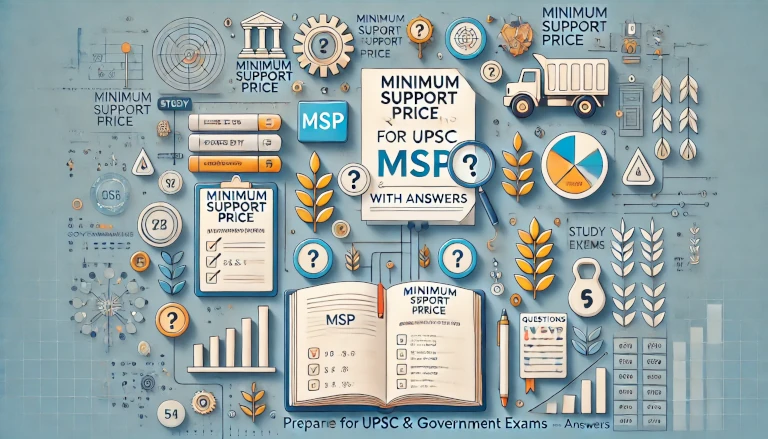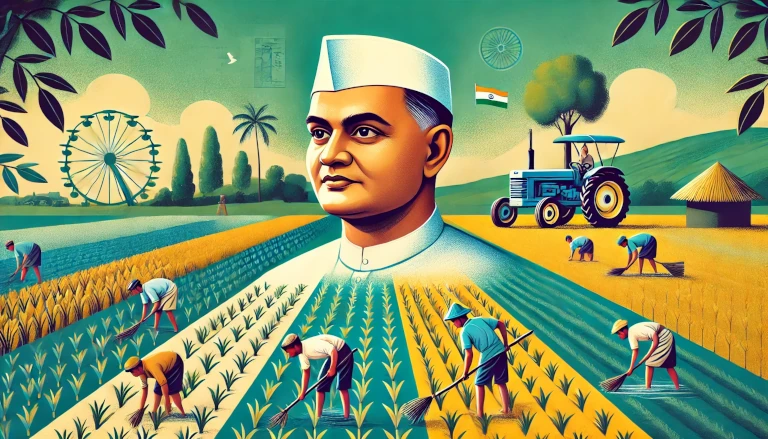Here is a compilation of questions related to Minimum Support Price (MSP) that have been asked in UPSC and other government examinations, along with concise answers:
- What is Minimum Support Price (MSP), and how does it function in India?
MSP is a price set by the Government of India to purchase directly from farmers, ensuring they receive a minimum profit for their produce. It acts as a safety net against price fluctuations and is announced before the sowing season for 23 crops, including cereals, pulses, and oilseeds. - Discuss the role of MSP in ensuring food security in India.
MSP encourages farmers to produce staple crops by guaranteeing a minimum price, thereby ensuring a steady supply of essential commodities. This mechanism supports the Public Distribution System (PDS), contributing to national food security. - Critically analyze the impact of MSP on crop diversification in Indian agriculture.
While MSP ensures stable income for farmers, its focus on certain crops like wheat and rice has led to monoculture, discouraging diversification. This practice can deplete soil nutrients and affect long-term agricultural sustainability. - Explain the process of determining MSP in India.
The Commission for Agricultural Costs and Prices (CACP) recommends MSPs based on factors like production costs, demand-supply dynamics, and market trends. The Cabinet Committee on Economic Affairs (CCEA) finalizes these prices. - Evaluate the effectiveness of MSP in protecting farmers from market volatility.
MSP provides a buffer against price drops, ensuring farmers receive a minimum income. However, limited procurement infrastructure and regional disparities can hinder its effectiveness, leaving many farmers without the intended benefits. - What are the challenges associated with implementing MSP across all regions and crops in India?
Challenges include inadequate procurement facilities, lack of awareness among farmers, and logistical issues. Additionally, MSP is more effective in regions with robust procurement systems, leading to regional imbalances. - Discuss the environmental implications of MSP-driven agricultural practices.
The emphasis on MSP for certain crops has led to over-cultivation, resulting in groundwater depletion and soil degradation. Sustainable agricultural practices are essential to mitigate these environmental impacts. - How does MSP influence the pricing of agricultural commodities in the open market?
MSP sets a price floor, influencing market prices by ensuring farmers do not sell below this rate. However, in the absence of effective procurement, market prices can still fall below MSP, affecting farmers’ incomes. - Analyze the role of MSP in the context of the World Trade Organization (WTO) agreements.
India’s MSP policy has faced scrutiny under WTO agreements, with concerns that it may distort trade by acting as a subsidy. Balancing domestic agricultural support with international trade obligations remains a challenge. - What are the recommendations of the Swaminathan Committee regarding MSP, and how have they been implemented?
The Swaminathan Committee recommended setting MSP at 50% above the comprehensive cost of production (C2). While the government has increased MSPs, the full implementation of this formula remains a subject of debate. - Examine the socio-economic impact of MSP on small and marginal farmers in India.
MSP aims to provide income security; however, small and marginal farmers often lack access to procurement centers and awareness, limiting their benefits. Strengthening procurement infrastructure and outreach is crucial. - Discuss the feasibility of providing a legal guarantee for MSP in India.
Providing a legal guarantee for MSP could ensure farmers receive assured prices. However, challenges include fiscal constraints, potential market distortions, and the need for comprehensive procurement mechanisms. - How does MSP affect the cropping pattern and agricultural productivity in India?
MSP influences farmers’ choices, often leading to the cultivation of MSP-supported crops. While this ensures income stability, it can discourage the cultivation of other crops, affecting agricultural diversity and productivity. - Evaluate the role of MSP in addressing agrarian distress in India.
MSP provides a safety net against price volatility, offering income stability. However, to effectively address agrarian distress, it must be complemented with measures like improved infrastructure, credit facilities, and sustainable practices. - What are the alternatives to MSP for ensuring fair prices to farmers?
Alternatives include direct income support schemes, crop insurance, and developing robust market linkages. These measures can provide income security without the distortions associated with MSP. - Discuss the impact of MSP on India’s fiscal budget and food subsidy bill.
High MSPs can increase procurement costs, leading to a higher food subsidy bill and fiscal burden. Balancing fair farmer compensation with fiscal prudence is essential. - How does MSP interact with the Public Distribution System (PDS) in India?
MSP ensures the procurement of food grains, which are then distributed through the PDS. This system aims to provide food security to the poor while supporting farmers’ incomes. - Analyze the regional disparities in the benefits accrued from MSP in India.
Regions with better procurement infrastructure, like Punjab and Haryana, benefit more from MSP, while others, especially in eastern India, receive less support, leading to regional inequalities. - What are the implications of MSP on India’s agricultural export competitiveness?
High MSPs can lead to higher domestic prices, making Indian agricultural products less competitive in the global market. Balancing domestic support with export competitiveness is a policy challenge. - Discuss the role of MSP in promoting sustainable agricultural practices in India.
Current MSP policies often favor water-intensive crops, leading to unsustainable practices. Reforming MSP to support eco-friendly crops can promote sustainability. - How does MSP impact the income disparity among different categories of farmers in India?
Large farmers with surplus produce benefit more from MSP due to better access to procurement facilities, while small farmers often miss out, exacerbating income disparities. - Evaluate the effectiveness of MSP in the context of the recent agricultural reforms in India.
Recent reforms aim to provide farmers with more market options. However, concerns persist about the future of MSP and its role in ensuring income security amidst these changes. - What are the administrative challenges in implementing MSP effectively across India?
Challenges include inadequate procurement infrastructure, delays in payments, lack of storage facilities, and ensuring timely dissemination of information to farmers. - Discuss the impact of MSP on inflation and consumer prices in India. High MSPs can lead to increased procurement costs, which may translate into higher consumer prices, contributing to inflationary pressures.
- How does MSP influence the credit availability for farmers in India?
MSP provides an assured income, which can make farmers more creditworthy. With the assurance of a minimum price, farmers may find it easier to access loans and manage repayment. However, without timely procurement, MSP alone may not improve credit access. - Analyze the relationship between MSP and farmer protests in India.
MSP is a key demand in many farmer protests, as it provides income stability. When farmers fear MSP reduction or elimination, protests often arise, underscoring MSP’s importance to their livelihoods. - How does MSP affect the rural economy and employment in India?
By guaranteeing prices, MSP boosts farmers’ income, leading to increased spending in rural areas and generating employment. However, limited MSP access can restrict these benefits in some regions. - What role does MSP play in promoting the Green Revolution crops in India?
MSP has historically favored wheat and rice, promoting these Green Revolution crops. While this has enhanced food security, it has also led to environmental challenges, such as soil degradation and groundwater depletion. - Evaluate MSP’s effectiveness in achieving India’s Sustainable Development Goals (SDGs).
MSP contributes to SDG goals like reducing poverty (SDG 1) and zero hunger (SDG 2) by providing income security to farmers. Yet, challenges in accessibility and sustainability need addressing to meet SDG targets effectively. - What are the implications of MSP on water and resource usage in Indian agriculture?
MSP’s focus on water-intensive crops like paddy has led to excessive water usage, impacting groundwater levels. Encouraging less water-intensive crops through MSP reform can promote sustainable resource use.
These answers provide an in-depth look at how MSP shapes Indian agriculture, addressing economic, environmental, and policy-related aspects essential for UPSC and government exams.
Discover more from Green Ecosystem - Renewable Energy, Agriculture, and Environmental Sustainability
Subscribe to get the latest posts sent to your email.


